ROTC Army cadets prepare for new fitness test
February 22, 2019
ROTC cadets reacted positively to the new Army Combat Fitness Test on Wednesday after they got the opportunity to test out its new changes.
“The cadets seemed to really like it,” said Cadet Morgan Hawk, a sophomore business management major.
The Army Combat Fitness Test hasn’t been changed since 1985. The current test includes pushups, sit ups and a two-mile run.
The good thing about the current test is that “you can do it anytime, anywhere and with no special equipment,” said Lt. Col. David Simms, a professor of military science.
However, the current test does not consist of activities soldiers would use during combat, Simms said.
ROTC cadets must complete the fitness test once a semester. The new test will begin this October.
“The new test replicates tasks accomplished in combat,” Simms said.
It will include pushups, deadlifts, power throws, leg tucks, a two-mile run and sprint, drag and carry.
The new test is more practical and suitable since it contains tasks that occur in combat, said Cadet Alex Warner, a senior exercise science major.
The new test will also be gender and age neutral, meaning the standards will be the same for all cadets taking it, regardless of gender or age.
Along with the positive feedback, some felt the changes also added some challenges to the test.
“I feel it’s more difficult because it requires skill,” Warner said. “It requires more effort and training.”
The deadlift may be more difficult for a lot of people, Warner said, since injuries can occur if proper form isn’t used.
The cadets were shown exercises to practice on their own to help prepare them for the tasks in the new test. They were pleased to see that there were additional activities for them to practice to help them train, Hawk said.
“I do think the changes made it more difficult,” Hawk said, since it’s more focused on working the muscles than the current test is.
Unlike the current test, cadets will not be able to rest between each task in the new test. This will probably be the hardest part for the cadets, Simms said.
“The fatigue will increase the difficulty,” Simms said.
Overall, the difficulty of the test will just depend on the soldier, Hawk said.
Since the new test requires access to a variety of equipment, Simms said it’s going to take time to obtain large quantities of the supplies needed in order to complete the test.
“It’s still in the testing phase, so it’s all subject to change,” said Cadet Jared Howard, a senior public health major.
Jill Golden covers non-traditional, ROTC and veterans. Contact her at [email protected].












